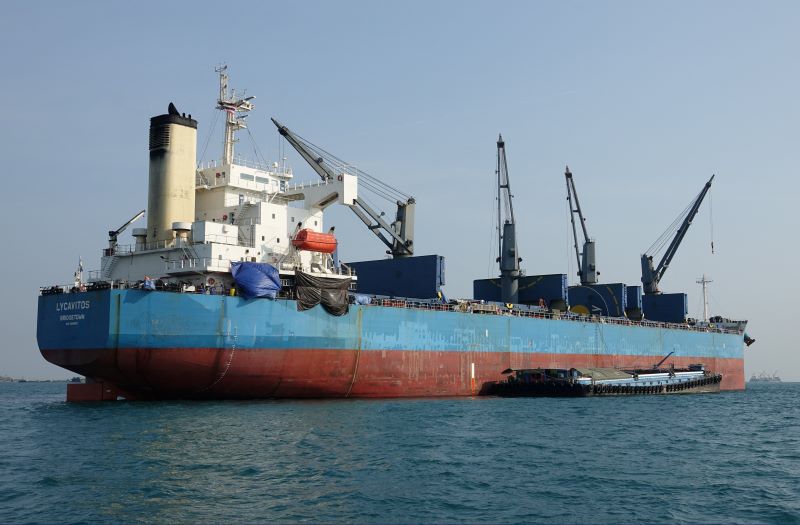Discussions about climate finance are usually framed around national borders: wealthy countries rightfully paying more than less-developed states for their historic responsibility in the climate crisis.
But holding only countries accountable for the damage done to our planet lets other polluters, often much larger than some major economies, off the hook.
We have a unique opportunity to rethink the whole approach, and set an important precedent where a major emitting industry – for the first time ever – pays for its greenhouse gas (GHG) emissions at the global level.
This industry is international shipping, whose global climate regulator, the UN’s International Maritime Organization (IMO), is meeting on March 11-22 to negotiate on policies to achieve its climate commitments and cut GHG emissions from ships.
This includes putting a price on shipping emissions, which the IMO has agreed to adopt in 2025.
Pacific “mixed feelings” after compromise on shipping’s climate goals
A multi-billion dollar sector powered by cheap fossil fuels, shipping has reached the point of emitting more pollution than all but the top five emitting countries worldwide. This is roughly the same amount as Germany or Japan in a year, and yet it remains almost tax-free.
Last year, the IMO reached a historic agreement to cut emissions 30% by 2030 and 80% by 2040, in order to reach net-zero by mid-century. This was in great part due to the valiant efforts of the Pacific Island delegations, who have for years now led the push for the highest ambition possible at the IMO.
Even though these targets fall short of what climate scientists say is necessary to limit global temperature rise to the Paris Agreement’s 1.5°C goal, it is in of itself the first deal of its kind. If achieved, it will help avoid over 10 billion tonnes of emissions cumulatively from now to 2050.
Polluters must pay their fair share
A growing number of governments and industry players back putting a price on international shipping emissions, so that polluters pay their fair share for the transition through a levy.
But the devil is in the details, and all eyes must be on the IMO, where the final decisions will be taken.
A well-designed levy will speed up the phase out of GHG emissions, help close the price gap between fossil and sustainable alternative fuels, and send a strong market signal to move towards zero emission solutions. But this must be done in a way that is just and equitable, particularly for those in the developing countries most impacted by the climate crisis.
Dozens of oil & industry lobbyists attended secretive shipping emissions talks
Crucially, a good levy will also generate significant revenues – between $1 trillion to $3.7 trillion could be raised by 2050. As called for by the Pacific islands at IMO, and supported by analysis from the World Bank, these funds ought to be allocated first and foremost towards supporting climate-vulnerable countries.
These revenues are new and additional, and completely separate from developed countries’ climate finance commitments negotiated at the COP summits. This is of paramount importance – otherwise we would be shifting the historic responsibility for climate change from developed countries, and their commitments under the UN climate convention, to industry.
These are two completely distinct and independent sources of funding.
The push for an ambitious levy
There are several levy proposals the IMO can choose from. The most ambitious one – which could secure a just and equitable transition – is a levy put forward by Belize, Fiji, Kiribati, the Marshall Islands, Nauru, the Solomon Islands, Tonga, Tuvalu and Vanuatu of $150/tonne of greenhouse emissions. A significant part of the revenues from this levy would go towards helping climate-vulnerable poorer countries fund shipping’s renewable energy transition, compensate for any rise in transport costs, and adapt to climate change.
The European Union has also recently reiterated its support for pricing GHG emissions, but is yet to support any specific proposal on the table. As the biggest negotiating bloc at the IMO, it is absolutely crucial that EU member states support a truly ambitious proposal, such as the one put forward by the Pacific Islands and Belize. Not doing so risks allowing momentum to grow around proposals that do not live up to the level of ambition we need at the IMO.
Other proposals currently on the table pose serious risks of incentivising the use of fossil fuels, such as LNG, and do not prioritise funds to support climate-vulnerable countries, which stand to lose the most from this transition without the right supportive measures in place.
We are at a crossroads – not just when it comes to shipping‘s climate action but also the way countries approach new and additional financial flows, and the March talks need to lead us in the right direction.
I urge governments not to miss this important opportunity, and make their voice heard at the IMO in support of an ambitious levy, such as the Pacific and Belize proposal, to get ships off fossil fuels and secure a globally just and equitable transition that leaves no country behind.
Ana Laranjeira is senior international shipping policy manager with Opportunity Green, an NGO working to unlock the opportunities from tackling climate change using law, economics, and policy. Since 2022, Opportunity Green has been working bilaterally with a number of ambitious climate-vulnerable IMO Member States towards building their capacity to actively participate in negotiations.
